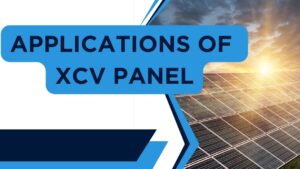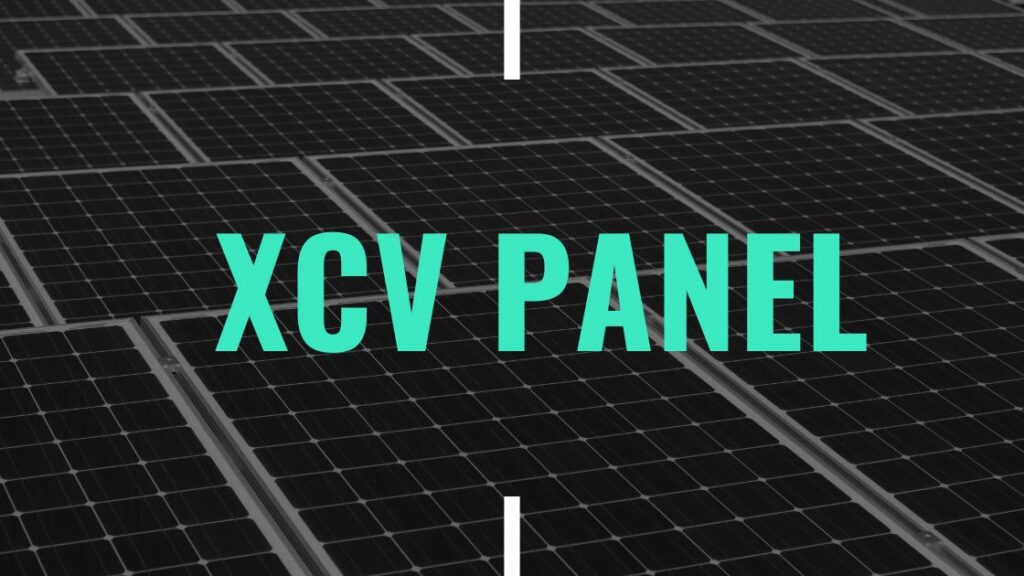The XCV Panel represents an innovative energy advancement growing increasingly important across America. Natural resources are depleting at an alarmingly rapid rate as our population increases; electricity generation was traditionally done using coal, but rising demands have rendered this resource too costly to generate power without depleting natural resources; electricity from solar panels provides cost-effective power production without depletion of natural resources – thus becoming viable energy alternative solutions today. At Alltimeupdates, you will get the correct details about the XCV Panel.
What is an XCV Panel?
We are transforming how we harness and use energy with the XCV Panel, a highly productive and versatile panel. Solar power generation and intelligent building materials can benefit from these highly efficient and adaptable panels. With advanced photoelectric cells, XCV Panels are more efficient than traditional solar panels at converting sunlight into electricity. Clean, renewable energy sources are in high demand, so this solution promotes sustainable energy use. Energy management systems also use XCV Panels to improve grid stability and optimize power distribution. They are versatile enough to support green building practices in the construction industry. A significant step towards achieving energy efficiency, sustainability, and innovation has been taken with the XCV Panel.
How Does the XCV Panel Work?
In terms of functionality, the XCV Panel can be divided into several key areas, each tailored to a specific application:
- Solar Technology: Photoelectric cells based on small, highly efficient XCV Panels work in this sector. A sustainable solution to energy needs is offered by these solar cells. Compared to traditional solar panels, the panels’ design allows for maximum sunlight absorption.
- Control and Visualization: XCV Panels can manage Automated and controlled systems more efficiently. Operational processes are enhanced by real-time data visualization, system monitoring, and control capabilities.
- Energy Management: XCVPs innovate in power distribution and energy management. The system uses innovative technology to optimize energy flow, ensuring electricity is distributed safely and efficiently. Adaptive response and real-time monitoring reduce energy waste.
- Innovative Building Materials: The construction industry is also changing with XCV Panels. Alternative building supplies are made with lightweight, adaptable, and eco-friendly materials. Simple to install, they reduce new construction’s environmental footprint and are designed for energy efficiency.
Also read: Driving Greatness: A Closer See at Wolfe Car Group LLC
How to install XCV Panel?
Planning and consideration are crucial to ensuring efficiency and safety when installing XCV Panels. Here’s a general guide to installing XCV panels:
- Site Assessment
A good source of sunlight should be available at the installation site. Trees, buildings, and other obstructions should be avoided. A southern-facing roof is ideal for northern-hemisphere rooftop installations. Optimal sun exposure also requires an angle for the panels.
- Obtain Necessary Permits
Ensure you know any permits, restrictions, and incentives from your local government and utility company that may apply to solar panel installation. Prepare the paperwork for a solar panel installation and operation in your area, and apply for permits.
- Choose the Right XCV Panels and Components
The type of XCV Panel to select will depend on your energy requirements, budget, and site assessment (e.g., monocrystalline, polycrystalline, thin-film). Additional components: Besides the panels, you will need inverters, mounting hardware, wiring, and possibly batteries.
- Install Mounting System
Installation of Mounting Brackets: Ensure the mounting brackets are correctly aligned and anchored securely. Fix rails or frames to mounting brackets after setting up the mounting structure. Panels made of XCV will be supported by this structure.
- Install XCV Panels
The XCV Panels should be mounted onto the mounting structure and secured with bolts or clamps. A secure fastener should be used to ensure that the panels are evenly spaced. Set the panels at the optimal angle to receive maximum sunlight, and adjust their orientation to face the right direction (usually south in the Northern Hemisphere).
- Electrical Connections
Connect the solar panels in parallel or series for the desired voltage and current. Home appliances can run on AC electricity generated by solar panels. By grounding the system correctly, you can prevent electrical surges.
- Connect to the Grid (if applicable)
Connect your system to the local utility grid if it was designed as grid-tied so any excess electricity can be fed back in. Measure energy flows into and out of your home: you may require a net metering meter that tracks this process of energy transference between home and Grid.
- Final Inspection and Testing
Ensure your installation meets local electrical codes by having a certified electrician or solar installation specialist inspect it. Test the system: Make sure the system is activated and monitored so you know it is functioning safely and efficiently.
- Maintenance
Maintain the system’s optimal functioning through regular inspections and maintenance checks. At these inspections and maintenance sessions, panels will be cleaned, while any damaged or loose components will be assessed for repair or replacement.
The Benefits of XCV Panels
Environmental, economic, and technological benefits are offered by XCV Panels because of their extreme conductivity and versatility. Benefits include:
- Ecological Sustainability: The XCV Panel works to mitigate carbon emissions through solar power, decreasing fossil fuel usage. Solar panels effectively convert sunlight to electricity production – an essential tool in fighting climate change and supporting sustainable energy solutions.
- Cost Efficiency: The XCV Panel maximizes energy production for maximum savings on electricity bills – offering consumers and businesses faster returns on investments while using less electricity than conventional panels.
- Versatility and Adaptability: These panels can be utilized in numerous locations, from residential rooftops to large-scale solar farms and building materials. Their adaptable nature adds extra appeal and utility as they suit multiple applications.
- Energy Independence: Reduce dependence on the Grid with XCV Panels. By utilizing renewable energy sources, we mitigate power outages and use less conventional energy.
- Innovative Technology: XCV Panels embody the latest solar technology innovation through advanced materials and design. In renewable energy technologies, their development drives further innovation and research.
- Longevity and Durability: XCV Panels are designed to withstand harsh weather conditions and environmental factors for many years to maintain their ecological benefits and cost-effectiveness.
Applications of Xcv Panel
Many sectors have found applications for XCV Panels, which combine efficiency, versatility, and sustainability. Uses include:

Solar power solutions for both residences and businesses alike
Electricity generation with XCV panels can be generated residentially and commercially thanks to their highly efficient solar cells that make for perfect rooftop installations, making XCV an excellent way to reduce energy bills and greenhouse emissions for homeowners and businesses.
Industrial energy solutions
XCV Panel can be utilized in industrial settings for powering manufacturing facilities, warehouses and other facilities. Their products reduce operational expenses while adhering to environmental regulations for businesses seeking cost-efficient yet sustainable solutions.
Agriculture
Powering irrigation systems, greenhouses and farm equipment using renewable energy sources is just one use case of XCV Panels that reduce operational costs while supporting sustainable farming practices with renewable power sources.
Public Infrastructure
Many public infrastructure projects use XCV Panels, including street lighting, transportation systems, and community centres. Urban and rural development projects are supported by their reliable and eco-friendly energy solutions.
Emergency and Remote Power
XCV Panels provide a reliable and portable power source for areas lacking access to the electricity grid. Reliability makes these batteries indispensable in remote regions, emergencies, expeditions, or military operations.
Building-integrated photovoltaics (BIPVs) generate clean energy.
Building materials like windows, facades and roofs that integrate XCV panels for maximum aesthetic value help increase power production with BIPV systems that produce electricity while adding aesthetic value. A BIPV system adds not only electricity production but also aesthetic enhancement.
Water purification systems
Solar-powered water purification systems using XCV panels offer access to clean drinking water sources in areas without readily accessible clean drinking water sources.
Educational and Research Institutions
Students across schools, universities and research facilities worldwide have been introduced to renewable energy technology through XCV panels.
Recreational and Off-grid Living
Cabins, RVs, boats and remote homes can use XCV Panels’ off-grid living capabilities to gain independence from utility providers while supporting sustainable living practices.
Smart Cities and IoT Devices
Smart cities rely heavily on IoT devices and sensors that monitor urban environments to foster intelligent energy-saving urban spaces powered by XCV panels.
Panel types of XCV
Various types of XCV Panels, known for their extreme conductivity, are available to suit different applications and efficiency needs. XCV Panels come in the following types:
- Monocrystalline XCV Panels: Monocrystalline solar panels convert sunlight into electricity at a remarkable rate due to the single-crystal silicon technology, producing electricity with superior purity and efficiency compared to other panels. Due to their greater capacity per square foot and high efficiency, they are the perfect solution for smaller areas.
- Polycrystalline XCV panels: Panels made of polycrystalline have less efficacy. Still, they are more economical than monocrystalline alternatives because they comprise multiple silicon crystals. They are popular with commercial and residential users, and their unique blue multi-coloured appearance helps these panels distinguish themselves.
- Thin-Film XCV Panels: Photovoltaic material is applied in thin layers on top of a substrate. Multiple materials may be utilized when fabricating thin-film panels, such as CdTe, Amorphous Silicon (a-Si), or Copper Indium Gallium Selenide (CIGS), making installations possible on surfaces like curves while keeping weight down with lightweight, flexible properties that make installation easy and less expensive than silicon panels. Thin film panels also boast greater versatility despite lower efficiency ratings than their silicon-based counterparts and lower costs associated with production – thus justifying lower manufacturing costs when producing them than their silicon counterparts!
- Amorphous Silicon (a-Si) XCV Panels: Noncrystalline silicon panels made with amorphous silicon are flexible and cheaper. Due to lower efficiency rates than their crystalline counterparts, amorphous panels are commonly seen in calculators and wearable devices.
- Biohybrid XCV Panels: Organic materials combined with traditional photovoltaic components to form biohybrid XCV panels represent an exciting breakthrough in solar technology, capturing light more sustainably and efficiently by replicating photosynthesis by harnessing sunlight for electricity production.
- Concentrated PV (CPV) Panels: A concentrated photovoltaic (CPV) panel employs mirrors or lenses to direct sunlight on an area with high-efficiency photovoltaic cells to ensure efficient power conversion. They are particularly efficient in dry climates. The high concentration of the sun allows the panels to turn more energy from their radiation to electricity than regular solar PV panels, making CPV panels particularly effective in tackling the electricity problem.
A few drawbacks of Xcv Panel
The advantages of XCV Panels include efficiency, sustainability, and versatility, but there are also some drawbacks. You need to understand their limitations to incorporate XCV Panels into your energy solutions. Drawbacks include:
- Initial Cost: While XCV panels save on energy bills over the long haul, their initial investment costs may still be significant. Financing options, subsidies and incentives may help offset some of this initial burden.
- Space requirements: It takes a lot of surface area to generate solar energy. Urban settings can make it challenging to install XCV Panels to meet energy needs, especially for individuals or entities with limited space.
- Weather Dependence: Weather conditions directly affect XCV Panel efficiency. On cloudy or rainy days, energy production can decrease significantly, which may require users to use stored energy or the Grid. Investment returns may be reduced in less sunny regions.
- Energy Storage: XCV Panels often need batteries to provide consistent power during nights or overcast days. The feasibility and sustainability of solar energy systems can be compromised by the cost and efficiency of battery storage systems.
- Environmental Impact: XCV Panels have an environmental impact, even though it is significantly less than fossil fuels. Materials and procedures used in manufacturing can be harmful. In addition, recycling solar panels after their lifecycle remains a challenge.
- Aesthetic Considerations: Certain architectural styles might not suit solar panels. While technological innovations have produced more aesthetically pleasing designs, homeowners or communities with stringent guidelines may find solar panels unattractive.
- Installation and Maintenance: Installing XCV Panels requires extensive knowledge, which may vary based on type and site conditions. Maintenance requirements tend to be minimal; however, cleaning or repairs may still be needed to achieve optimal performance.
Best Alternatives to XCV Panels
Several renewable energy solutions and technologies that complement solar power, including XCV Panels, offer a sustainable and efficient way to harness solar energy. Alternatives include:
- Wind Turbines: Wind energy can also provide renewable sources of power generation. Wind turbines can generate electricity at home and work; solar panels may supplement or be replaced altogether in areas with high winds by using windmills instead.
- Hydroelectric Systems: Hydroelectric systems offer an attractive option to properties near flowing waters, where energy can be generated via turbines powered by water flow. Unfortunately, they don’t guarantee constant and dependable energy provision everywhere they’re installed.
- Geothermal Systems: Geothermal systems utilize heat from deep within the Earth to generate power or warmth for electricity or heating production, with lower operational costs and minimal environmental impacts than many traditional heating sources. Although installation costs can be high, geothermal energy systems provide long-term savings and reduced environmental impacts compared to their counterparts.
- Bioenergy Systems: Bioenergy can be described as an exciting, sustainable energy source that can control waste by transforming trees, plants, and scrap materials into heat or electricity.
- Solar Thermal Systems: Solar thermal systems use sunlight to warm either air or water for heating and hot water systems and industrial processes. They do this by directly converting the sun’s energy into electricity instead of instantly generating it. If energy production is the primary goal, the solar thermal system is usually cheaper.
- Hybrid Solar-Wind Systems: Hybrid energy solutions that combine solar panels and wind turbines are more secure, particularly during cloudy or nighttime conditions when wind power may complement solar output – providing reliable off-grid solutions.
- Microhybrid Technology: Waste energy from vibrations and thermal gradients can be captured and recycled using energy harvesters in electronic devices and vehicles, helping reduce energy use while improving efficiency and offering another avenue for large-scale energy production.
- Nuclear Energy: Nuclear energy can provide huge-scale, non-renewable energy production that is not directly accompanied by any carbon emissions, but radioactive waste can pose safety risks.
- Energy Storage Solutions: Energy storage solutions such as lithium-ion battery flow batteries and compressing air storage for energy to make renewable energy sources more reliable over time. Not only are energy storage technologies beneficial during peak times, but they also store excess power produced during them for later consumption when demand spikes.
FAQs of XCV Panel
Questions and concerns about the XCV Panels can be clarified by creating a Frequently Asked Questions (FAQs) list. FAQs and answers:
What are XCV Panels?
These panels were explicitly developed to be highly efficient and versatile across various applications – traditional solar panels tend to be ineffective at turning sunlight into energy.
How do XCV Panels work?
Photovoltaic cells on an XCV panel convert sunlight directly into direct current (DC) before an inverter converts this DC electricity to AC electricity suitable for use by residential, commercial and industrial properties.
What makes XCV Panels different from traditional solar panels?
Efficiency and adaptability set them apart, with XCV panels offering more excellent sunlight conversion to electricity conversion efficiency, leading to higher efficiency overall, and their versatile designs enable use in various settings.
Can XCV Panels work on cloudy days?
Although less efficient, XCV panels can produce electricity even on cloudy days by collecting sunlight and turning it into energy. Sunlight captured by them is then converted to energy, which powers their operation.
Are XCV Panels environmentally friendly?
Solar Panels from XCV reduce greenhouse gas emissions by harnessing clean and renewable energy from the sun to generate clean energy for use, making them environmentally friendly. Furthermore, manufacturing solar panels produces waste material, which must eventually be dealt with or recycled appropriately before finally ending up as solar energy solutions for others to use or dispose of in some manner.
What is the lifespan of an XCV Panel?
Based on their quality and environment of use, XCV Panels typically last 25-30 years when properly maintained. Their lifespan may even extend further if their proper care is maintained.
How much do XCV Panels cost?
Various factors determine the cost of XCV panels, including system size, panel type and installation expenses. Production costs have decreased due to tax credits, incentives from financial institutions, and declining tax rates.
Do XCV Panels require maintenance?
The XCV Panel requires minimal maintenance, mainly cleaning and removing debris to ensure optimal performance. Professional maintenance can keep them efficient and long-lasting.
Can I install XCV Panels myself?
XCV Panels can be installed by you, but professional installation is highly recommended for safety, efficiency, and warranty compliance.
How do I choose the right XCV Panel system for my needs?
Energy needs, space availability, budget constraints and local climate conditions must all be considered when selecting a solar energy system for use at home. A knowledgeable provider can assist with choosing an effective option explicitly tailored to meet their customers’ requirements.
Conclusion
Solar technology has advanced significantly with XCV Panels, offering more effective, sustainable energy production methods. By efficiently turning sunlight into electricity as conventional panels, XCVs make an attractive option for reducing carbon footprints and energy bills. They offer environmental sustainability, potential cost savings, and meeting space requirements and initial investments more effectively than their rivals. As technology develops, their use will increase, transitioning toward cleaner, renewable power generation sources.

